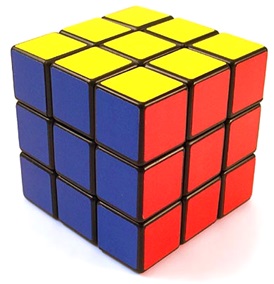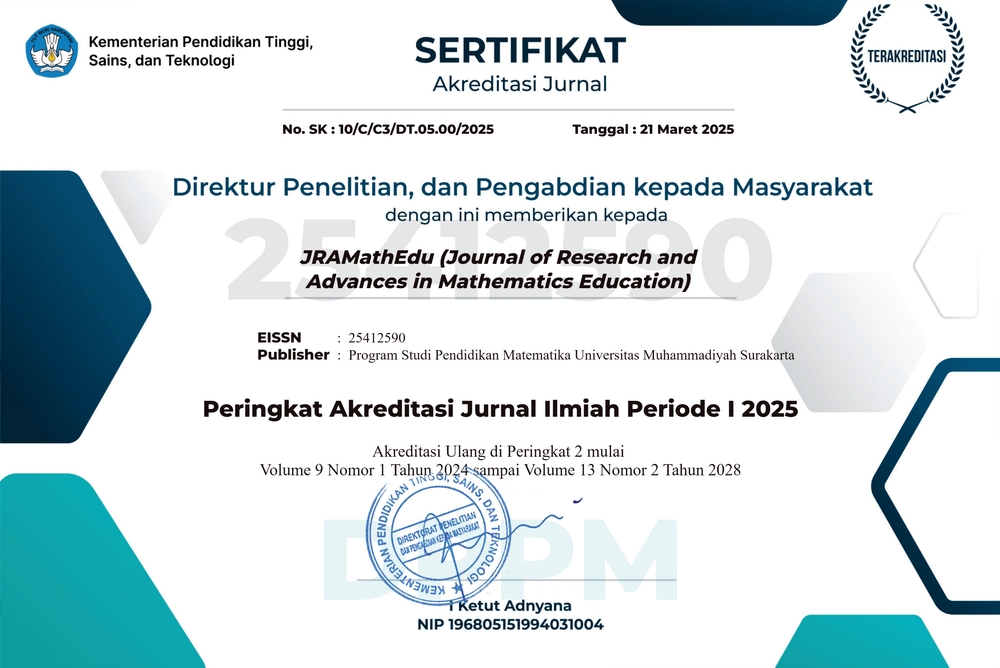Visualization of finite groups: The case of the Rubik's cube and supporting properties in GeoGebra
DOI:
https://doi.org/10.23917/jramathedu.v9i4.5516Keywords:
Rubik's cube, Group Theory, Permutation Groups, GeoGebraAbstract
In this text, we present a discussion about the Rubik's Cube and its relationship with Group Theory, particularly permutation groups, as well as possibilities for exploring it using the GeoGebra software interface. We bring a brief discussion about the concept of group, aspects of the Rubik's cube, the Rubik's group as a group of permutations and possibilities for its exploration in GeoGebra. Based on this study, we recognize the potential to delve into permutation groups in Abstract Algebra through a visual interface that associates their properties with a tangible and manipulable object. Additionally, there is the potential for simulating their movements using Dynamic Geometry software, such as GeoGebra. These findings highlight the relevance of GeoGebra as a useful tool for visualizing and understanding permutation groups, promoting a more intuitive and accessible approach to Group Theory in the educational context.
References
Alves, F. R. V. (2019). Visualizing the Olympic Didactic Situation (ODS): Teaching mathematics with support of the GeoGebra software. Acta Didactica Napocensia, 12(2), 97-116. https://doi.org/10.24193/adn.12.2.8 DOI: https://doi.org/10.24193/adn.12.2.8
Alves, F. R. V. (2022). Didactic Engineering (DE) and Professional Didactics (PD): A Proposal for Historical Research in Brazil on Recurring Number Sequences. The Mathematics Enthusiast, 19(1). https://doi.org/10.54870/1551-3440.1551 DOI: https://doi.org/10.54870/1551-3440.1551
Bandelow, C. (1982). Inside Rubik’s cube and beyond. Birkhäuser Boston. DOI: https://doi.org/10.1007/978-1-4684-7779-5
Carter, N. C. (2009). Visual Group Theory. Bentley University. DOI: https://doi.org/10.1090/clrm/032
Chen, J. (2004). Group Theory and the Rubik’s Cube. (Lecture notes). Texas State Honors Summer Math Camp.
Davis, T. (2006). Group Theory via Rubik’s Cube. Class notes. Available at: https://docplayer.net/252967-Group-theory-via-rubik-s-cube.html
Davvaz, B. (2021). Groups and Symmetry: theory and applications. Springer. https://doi.org/10.1007/978-981-16-6108-2 DOI: https://doi.org/10.1007/978-981-16-6108-2
Garcia, A., & Laquin, Y. (2002). Elementos de Álgebra. Projeto Euclides. IMPA.
Gonçalves, A. (1995). Introdução à Álgebra. Projeto Euclides. IMPA.
Joyner, W. D. (1997). Mathematics of the Rubik’s cube. Faculty of Physics, University of Warsaw.
Joyner, W. D. (2008). Adventures in Grout Theory: Rubik’s Cube, Merlin’s Machine, and other Mathematical Toys. The Johns Hopkins University Press.
Monteiro, A. T. M., Moura, L. F. C. M. & Fonseca, R. V. (2019). Grupos Diedrais: uma proposta concreta para uma apresentação inicial da Álgebra Abstrata para licenciandos em Matemática. Revista Matemática e Ciência: conhecimento, construção e criatividade, 2(2), 56-86. https://doi.org/10.5752/P.2674-9416.2019v2n2p56-85 DOI: https://doi.org/10.5752/P.2674-9416.2019v2n2p56-85
Romero, R. E. (2013). Las matemáticas del cubo de Rubik. Revista Pensamiento Matemático, 3(2), 97-110.
Travis, M. (2007). The Mathematics of the Rubik's Cube. University of Chicago.
Schültzer, W. (2005). Aprendendo Álgebra com o Cubo Mágico. V Semana da Matemática da UFU. UFSCar.
Vágová, R., & Kmetová, M. (2018). The Role of Visualisation in Solid Geometry Problem Solving. Proceedings of 17th Conference on Applied Mathematics, Bratislava, pp. 1054-1064.
Warusfel, A. (1981). Réussir le Rubik’s cube. Éditions Denöel.
Wussing, H. (1984). The Genesis of the Abstract Group Concept. Dover Books on Mathematics.
Zazkis, R; Dubinsky, E., & Dautermann, J. (1996). Coordinating visual and analytic strategies: a study of students’ understanding of the Group D4. Journal for Research in Mathematics Education, 27(4), 435-457. https://www.jstor.org/stable/749876 DOI: https://doi.org/10.5951/jresematheduc.27.4.0435

Submitted
Accepted
Published
How to Cite
Issue
Section
License
Copyright (c) 2024 Renata Teófilo de Sousa, Francisco Régis Vieira Alves, Ana Paula Aires

This work is licensed under a Creative Commons Attribution-NonCommercial 4.0 International License.


















